Reader Kymm was kind enough to load me this rifle to video, with a particular interest in seeing the amount of gas leakage (or lack thereof) on high-speed footage. This early model of Sharps featured a sliding sleeve inside the chamber, which was intended to push backwards into the breechblock under pressure when firing, and thereby seal the breech. In practice, however, powder fouling would very quickly seize the sleeve in place. Later iteration of the Sharps would use a more effective platinum ring on the breechblock to seal the action, before finally giving way to use of brass cartridge cases (which eliminated the gas seal problem once and for all).
I was unable to ascertain the true history of this particular Sharps, unfortunately. It is an 1852 pattern rifle, which is rather rare, and does not have a patchbox in the stock. The top of the barrel is marked “D.C. HODGKINS & SONS MACON GA 1862” which would seems to suggest Confederate provenance, but I can’t find a reference to Hodgkins working on this type of rifle. Also, I am automatically skeptical of any potential Confederate weapon, simply because of their scarcity and the number of fakes made. Authenticating Civil War era firearms is not my forte, and if anyone can shed some light on the history of this one I would be very interested. It did feel authentic, as far as that gut feeling goes…







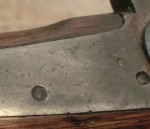

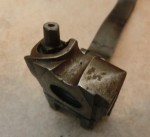
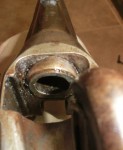
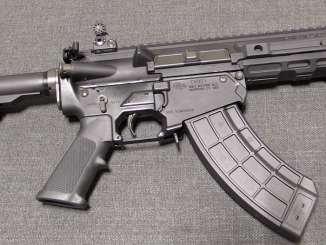
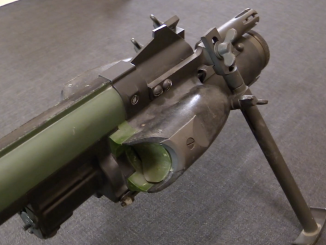

Ian
ouch !!!, hope the arm is ok i did the same < going to switch to smaller bullet and see if i cant use heat to release the moving breech
Is that akin to sunburn? In practical terms is it possible to shoot well while avoiding that?
I’d say a leather jacket would be a necessity for sustained use of one of these. Or in hot weather, an archer’s forearm “bracer”. Preferably one of the larger ones that at least partly protects your off hand as well;
http://www.3riversarchery.com/Robin+Hood+Bracer_i8540X_baseitem.html
The later Sharps breech seal, BTW, was very similar to the “Broadwell ring” breech seal used in breechloading artillery;
http://www.google.com/patents/US2468134
It was fairly effective, but unless the alloy was “just right”, the ring would either erode rapidly or develop cracks. In artillery, it was soon superseded by the de Bange “pressure pad” breech seal.
It must be remembered that Sharps only made rifles with the second pattern breech seal for a short tie, from about 1860 to 1865. After that, Sharps shifted to metallic cartridges. And of course, after Christian Sharps’ death in 1874, the company was gone by 1878. So for about half its existence, it made metallic cartridge arms exclusively.
If not for the numbers produced for military contracts during the American Civil War and to a lesser extent to British contracts for the Crimea and in India, the “cap-and-ball” Sharps would have been little more than a footnote in firearms history.
cheers
eon
Copper ring obturation was used by Krupp and Skoda long after the French and British armies had adopted de Bange obturation. They favored sliding breech block design, which made using the de Bange system practically impossible (modern sliding block designs do provide obturation derived from the de Bange principle). The main drawback of the Broadwell ring was fouling, which could make it leak if not kept clean, but that problem was partially solved by the introduction of smokeless powders. Interrupted screw breech with de Bange obturation was still somewhat more reliable and slightly simpler to manufacture, but sliding block was faster to open and close until single-motion screw breech was developed during WW1 (so called Asbury mechanism, which was a development of the earlier two-motion Welin screw breech).
However, in the end Krupp and Skoda decided to use a brass propellant case for obturation in artillery pieces up to 152 mm, which had the added benefit of making loading the gun faster and removed any problems with sealing reliability, but of course added the price of the brass case. The Soviets also adopted that technique after WW1 for their 122mm and 152mm artillery pieces and the Russians continue to use it for ammo commonality and extreme reliability under field conditions. Some French WW1 designs also used propellant cases, but for cost reasons the French returned to de Bange system and bagged charges.
Additional note: all of the above applies mostly to artillery pieces in the 120-152mm range. Smaller bore artillery pieces by from the 1890s to WW2 and beyond used fixed (cartridge type), semi-fixed or separate loading cased charge ammunition; these artillery pieces were called Quick Fire (QF) in the British designation system. Modern 105mm pieces use either semi-fixed or separate loading ammo.
how uncomfortable do the escaping gases feel ?
Cool old “Sharps.” There is a possibility that this is an actual Confederate copy of a Sharps, but the provenance is not direct as no actual records exist. However, the Cranmers at IMA found a number of these 1852 pattern Sharps copies in the cache of arms taken from the Nepalese royal armory. The rifles were unmarked, and contained some locally (Nepalese) made parts, suggesting that they were purchased from captured stocks of incomplete Confederate-made Sharps clones. The clincher was a single revolver of a previously unidentified type marked with the D.C. Hodgkins and Sons, Macon GA stamp found along with these Sharps copies in Nepal. One theory is that the guns/parts were captured from the GA State Armory (Formerly the Hodgkins works) at the end of the war, and were later sold as surplus on the international market, with a number of them ending up in Nepal, likely through a British middleman. Another (more unlikely) theory states that the guns were produced by Hodgkins in the late 1850s for export to Asia. A third theory is that a handful of Sharps copies (along with the aforementioned revolver) were assembled by Hodgkins from parts imported from England.
On this particular specimen, several things stand out that may suggest Confederate origins. First, age and wear aside, tool marks, fittings, and the lack of a disk-priming tube (at least what I can discern from the photos) suggest this is not a product of the 1852 series of Sharps rifles. Also, the full-stock and lack of a patch-box indicate that it is not a product of the Sharps/Robbins and Lawrence concern from the 1852 series. As for Hodgkins producing these, “expert” opinions vary from possibly to definitely not. Thomas Griswold (of Griswold and Gunnison revolver fame) took over the Hodgkins works in mid-1862 and all arms production in Macon was later taken over by the Confederate (GA state) government. If these Sharps copies were produced by Hodgkins, it would have been between 1860-1862 (or perhaps earlier). Lack of existing records, the chaotic nature of Confederate arms production and importation during the war, and generations of “experts” with personal axes to grind and/or profits to make further complicate the issue. Is this example a rare Confederate copy of a Sharps 1852? The possibility exists. Is it an original 1852 Sharps made by Robbins and Lawrence? It doesn’t appear so. Is it a fake? In the absence of actual provenance, that is the safe bet, but there is some evidence that this rifle may indeed be what it appears to be.
I wanted to add a couple of observations to my previous post. S.C. Robinson of Richmond VA manufactured a number of 1855 Sharps copies for the Confederacy (approx. 3000) between 1861-1864, when the facility was moved to Tallassee, AL under Confederate Gov’t. orders, where a few more, unmarked examples were produced. Like the rifle in the OP, the quality was not nearly as good as the original Sharps products. It is said that Robert E. Lee commented that the Robinson carbines were of such poor quality they were bad for the morale of the troops unfortunate enough to be issued with them. Thus, the ability of the Confederate arsenals/contractors to produce such a relatively complex weapon as the Sharps was obviously lacking. If D.C. Hodgkins and Sons did try to produce a copy of the 1852 Sharps, it is probable that they were unable to produce a functional example in any notable quantity and the extreme rarity of a complete example, as well as the existence of some unmarked actions/incomplete rifles/carbines turning up in a foreign country, combined with a lack of records indicating actual issue and use of these weapons by Confederate forces may be the result of an aborted attempt by Hodgkins to produce these weapons, either from scratch or by adding stocks, barrels, and fittings to a few English-made imported actions. The 1862 markings on the example in the video may represent a working prototype produced at the end of Hodgkins existence as a separate corporate entity before its purchase by Griswold and subsequent takeover by the Confederate Ordnance Dept. By this time, the emphasis would be on producing and repairing quantities of simpler muzzle-loading designs due to a lack of materials and the loss of many skilled laborers and machinists, most of whom had volunteered for service in the Army. The cost in and lack of labor and materials would have made quantity production of this rifle in Georgia nearly impossible by 1862. The surviving actions would likely have been set aside and later acquired by surplus dealers after the war, and any completed rifles would have filtered out of the arsenal as individual pieces for militia use, rather than generally issued items. Now, all of this is pure speculation based on accumulated and often conflicting data, but I do have a few Civil War weapons, and have done a bit of research on the subject of Confederate arms. Taking all that into consideration, this rifle may be authentic, although absolute proof simply doesn’t exist. That would leave most to determine it fake, but there is some circumstantial evidence (and a bit of a gut feeling) that this is a rare gem. All in all, it is a fascinating mystery.
Doc; I found your assessment interesting. My grandmothers grt.uncle was CSA Gen. Braxton Bragg. and it is well known that CSA was NOT as well situated for the manufacture of Firearms as was the New England vicinity. Now, here is a fact that few have mentioned: The secession movement began (as I learned) in the E. 1850’s. Confederate leaders were purchasing arms fro England. The fact that C.Sharps rifles & carbines were produced in the L. 1848-52 period. These were available on the open market for 8-10years before the conflict began. I truly believe that CSA was quite interested in Sharps as well as other makers. That said, why would the Confederate gov’t having years of planning to compile a large assortment of weaponry NOT(incl. Cannons primarily) to arm its military before the actual conflict started in earnest. During this period of anxiety on both sides why would the CSA pursue the Sharps as well as other mfg’s. Bear in mind in making up clones to the C. Sharps obviously was more intricate than what appeared exterior wise. The CSA/Gov’t simply did NOT began to clone the Sharps after the conflict began more likely a bit earlier. An unk. amount were quite likely ‘prototypes’…and most likely the Confederate gov’t. decided to abandon its mfg. of the Sharps as it more likely was cheaper to purchase ready made long guns from the Brits and save precious time from mf’g. its own. Of course as these Sharps clones were made during this period of history there would be NO reason to make a “stamp’ to indicate whom made these weapons. As far as provenance…the provenance is there BY NOT having any to declare the via the ‘cloner ! Obviously these were made from machinery that was simply NOT available to Nepalese sources. The term “fakes” in my mind an improper term as these simply were copied and NOT to influence the military nor public they were produced nefariously. I have my own copy of the Sharps ‘slant breech carbine in near perfect condition and NOT a refurb job. Yes, it came from the cache in Nepal from whatever reason. Obviously the Nepalese were NOT seriously interested in manufacturing them when like the Southron brothers were not set up either. I happen to be very content w/ my Sharps clone….just sayin…!
In the last year I’ve done some studying of the militia records in the 1855-1862 time frame.
I was very surprise to see how many guys showed up for there 1st muster into a local unit with Sharps. In some units 25-30% of them showed up with them in 1861. I had always assumed that Sharps were rare until during the war.
Looks like one of the IMA Nepal made Sharps with the long barrel and P1853 sight. Barrel marks look like a modern stamp.
Good catch. The stamp on the barrel of this Sharps copy doesn’t share any resemblance to the stamp on the Hodgkins revolver.
Great find Ian. What did you use for the paper in the cartridge? How sensitive the rifle is for paper strength? not being strong enough to push the bullet far enough forward vs. not shearing the back off the cartridge. The gas leakage looks as bad or worse than the 1860 revolver. It would be interesting to compare the gas leakage to that of a later model paper cartridge Sharps. I’ve seen a couple of that era of Sharps rifle for sale and thought they would be a great addition to a collection as the last development of the pre-metallic cartridge era.
I have worked at IMA for just over three years, specializing in restoration and preservation. I have completed a large number of Sharps type rifles and carbines, making detailed notes on variations of their components. For example, three variations of receivers have been observed. I agree that some parts appear to be “home grown”, while others are well finished. We hope to publish all of my findings and other research results, at a future date. I think that we can all agree that,of all the guns to come out of the palace, the Sharps are the most enigmatic and how and why they were there is still a question to be answered. If you have questions, or comments and would like to contact me, please do so at, occupant4g@aol.com.
Thank you.
To: Mr. Rob Adams/other interested individuals ref. The Sharps Carbine/rifle of unk.heritage. I being a former investigator have read many interesting comments positive along w/naysayers. In looking over a Carbine specimen that I own, I am of the opinion that these “unmarked” weapons of war are & were manufactured BEFORE the U.S. Civil War began. In knowing the conflict began circa 1850-60 the Nation was slightly and increasingly preparing for ‘battle. For a financially prepared group of individuals to start production of a “clone” to copy the Sharps weapon(s) would necessitate much legal finesse/hassle. For “any” weapons mf’g. of southern location knowingly “copy” selected Sharps nor other Northern weapons makers WAS actually submitted and completed..! Some were “unmarked” as perhaps “tool room copy” and quite likely untold thousands (may) have been produced to be (later) lettered/marked/stamped.! It IS well known the United Kingdom did manufacture weapons to be offered/purchased by the Confederate States of America in preparation for the upcoming conflict…! Why would not British weapons mfg’s be capable to clone ANY US firearm of the period we are discussing..?? I believe the “answer” lies most likely in British archives unearthed(?) and/or in assistance from southern weapons manufacturers. How Nepalese weaponry of Sharps & others strt with British influence in India/Nepal & elsewhere. Was Nepal in conflict at this time period of 1850’to mid 1860’s..?? I would imagine so as I am not particularly interested in their history…yet…appartently 1,000’s of firearms up to WW1 were located concealed in Nepal as ‘clones…!IF enough research is completed..the answer(s) will be revealed…stay tuned.
It’s noteworthy that the stocks of the Nepal Sharps rifles and carbines were made from Honduran wood. British Honduras, or what is Belize today, was where ex Confederate patriots settled after the Civil War. Their efforts to establish colonies and sugar cane and logging industries there failed in the long run. However the Nepal Sharps do seem to have a link with the Confederacy in that regard, being made with (British) Honduran Mahogany,
Greetings Fred;…in reply to your posting..I agree with your research. Should I/others live long enough..hopefully the answer will be revealed in reference to “who/when/where & how these magnificent clones(SharpsCarbines)were manufactured. i believe I am fortunate to possess a moderately “pristine” example. I also own (2) Original Sharps ‘slant breech Carbines…and to compare the “clone” to the original(s) display near identical machining..! Strange indeed..! Let us keep researching the subject.wherever it may lead.
Yes! I think that although the particular rifle that the original poster owns probably has a fake stamp, there is compelling evidence suggesting that the Nepal rifles and carbines may indeed have a Confederate association.
I’d be interested in learning just what the different rifle variations are.
The rifle pictured has a breech block hinge retaining spring and so the sling swivel is omitted. Interesting.
Having read this I believed it was really enlightening.
I appreciate you finding the time and energy to put this content together.
I once again find myself spending a lot of
time both reading and commenting. But so what, it was still worth it!
Greetings again my fellow “Sharpists”….Allow US to NOT get all wrapped up in whom DID-or-DID NOT clone the SHARPS CARBINE. I focus on the “carbine” as it simply offered the most appeal to skirmishers/mounted cavalry & perhaps a few selected troopers on foot. Using a “musket w/bayonet and the longer battle..the SHARPS NEVER produced any I am aware of and were an expensive product to mfg.-period. YES, he Brits had been making “muskets” of variety for decades BEFORE “our” Republics disunion began in earnest. The simple fact remains the US Gov’t(Union) along w/ the CSA(Rebels) DID purchase many of the British Enfield MUSKET…cheaper than we could mfg. that same weapon..as I understand history’s figures of producing weaponry. So, allow us to return to the SHARPS mystery..let’s face fact..The US Gov’t nor the CSA could give a ratzass on Nepal or its fears…and certainly..NEPAL felt same towards OUR National Dilema..! Fact remains in the “legality” of producing CLONES of currently produced weapons. There at that period in our history “copyright” laws DID exist and were enforceable even back then..! So, as I see this whole series of “blather” MINE included by the way is not very difficult. I challenge ANYONE to verify any “undocumented” firearm from that period that-that firearm was definitely made by so & so. Another fact reveals itself…WHY would any mfg. at that period in OUR Civil War wish to manufacture a firearm that basically for lack of a better term was “obsolete” in respect to paper vs. the newer metallic cartridges more commonly used towards the END of our conflict. The fact that WE are focusing on the 1852-63 variant of the famous SHARPS…the slant bree ch variant(s) of CARBINE seems to be the focus..NOT the Musket. So, the Provenance reveals itself in MY opinion by NOT displaying any proof as to whom produced it…CERTAINLY NOT NEPAL..! I have no axe to grind w/Nepal…but as I see it..they were still trying to keep the Wheel in a 360 deg. circle. My (2) “undocumented” Sharps Clones are in near pristine condition & slightly used in the field of battle…incl. BORES. One displays the 1852 variant where the forearm has the Springfield style long horizontal spring retainer for the cocking axle at the R.side end of the forearm at breech…the other variant is the 1853 model whereas ONLY a “pin” is in place within the lower frame to keep same cocking lever in place…VERY interesting for BOTH being “undocumented”…I rest my case…Guy
Do you have any photos of the sliding sleeve removed from the barrel’s breech? Must the barrel be removed from receiver to extract the sliding sleeve?
Has anyone tried using “Permatex Copper Anti-Seize” Lubricant for lubing the sliding sleeve?